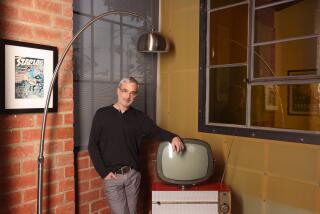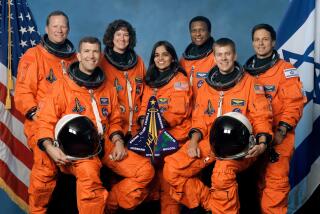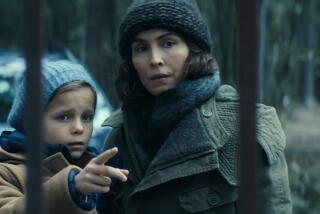From Space, Itâs Earth That Beckons
MADISON, Wis. â When we walk outside at night, we are anchored by gravity to the ground. Perhaps thatâs why we look up. City dwellers, like myself, scan for the thin scatter of stars visible through the urban light haze, the rare bright spark of other, distant worlds.
Shuttle astronauts, as they float some 200 miles overhead, find their gazes drifting down. Out there in the black and silver elegance of space, they seem drawn to what theyâve left behind. And I wonder whether there could be anything more beautiful, more terrifyingly vulnerable, than the sight of Earth from orbit, so gem-like in its shifting color and watery glitter.
âLooking outward to the blackness of space, sprinkled with the glory of a universe of lights, I saw majesty -- but no welcome. Below was a welcoming planet. There, contained in the thin, moving, incredibly fragile shell of the biosphere, is everything that is dear to you,â writes American astronaut Loren Acton, who logged 126 Earth orbits in the mid-1980s.
The shuttle program was only a few years old then, but it didnât take long to recognize its unbreakable bond to earth. I learned about it the hard way as a newspaper reporter covering the space program. In January 1986, as a news reporter covering space science, I spent a glorious week in Pasadena, at the Jet Propulsion Laboratory, covering the arrival of the Voyager 2 spacecraft at the planet Uranus. The two Voyagers were wonderful, reliable little spacecraft, and this one sent back photographs that had scientists and journalists alike leaping to their feet, images of a planet so fantastically un-Earthlike in texture and shape that it was almost like dreaming.
And then, on Jan. 28, I went straight from Pasadena to Houston. The shuttle Challenger had exploded on liftoff. It was a tumble from grace into a nightmare of anger and grief and frustration. The National Aeronautics and Space Administration made everything worse by locking down. Every question was turned away. We were denied even the ground temperature at time of launch. Journalists began lurking in agency parking lots to waylay employees. At memorial services, we shared rumors.
There seemed nothing left of that earlier incandescent moment of discovery. And most of us, I suspect, held only faint memories of Voyager 2. Today we remember, because it matters so much to us, the incendiary death of Challenger and its crew. We remember being here before, watching the silver streak of fighter jets across the blue Texas sky, falling away in the missing-man formation, and we wish all over again for the safe return that wasnât.
This time, though, the space agency remained so much less defensive, more open in its own sense of loss. We were instead reminded, as we should be, how much astronauts knowingly risk when they strap themselves in for launch. But itâs also important to remember that neither crew died in some exotic stretch of deep space. Since our space program began, the United States has lost 17 astronauts on the job, and none of them in orbit. Three Apollo astronauts were killed in a launch pad fire during a training exercise in 1967; this was followed by the Challenger launch explosion in 1986 and now the shattering of Columbia, 40 miles above ground.
The pattern should remind us not that space is dangerous but that we are. We make mistakes. We launch and we land with overconfidence. We may -- as some critics now suggest -- cut safety by cutting costs. The most real dangers to our very human astronauts are decisions made by other humans. In that sense, the astronaut deaths are not so different from all the thousands of workplace deaths reported every year in this country. On our well-known planet, we are still learning to do it right, and the shuttle illustrates that, sometimes painfully well.
In this long, gray week since the shuttle Columbia broke apart, itâs been heartbreaking to consider how near the seven astronauts aboard were to home. Back in our atmosphere, they died just 16 minutes from landing. They must have anticipated the welcoming crowds of family and fans and fellow NASA employees waiting for them, down at Cape Canaveral, Fla.
But it seems to me that this sense of coming back to Mother Earth is at the very heart of what makes the space shuttle so remarkable and so dangerous and so necessary all at once. The shuttle program has never been about those distant sparks of light that I watch from the sleepy safety of my residential street. It is the most home-based of all our space programs, the most tethered to the spaceship we most love and need, our own planet.
There are those who argue that what we learn from the shuttle will eventually allow us to move deeper into space. Perhaps. But for now -- and for the foreseeable time to come -- the shuttle does its real work close to home. It orbits Earth like an impossibly odd and tiny moon and it explores what President Bush, in his memorial remarks, called âthe unmapped darknessâ around us. It ferries people and cargo and supplies to the international space station and back; in fact three astronauts on the station await a shuttle return even today.
It was never meant to engage in some grand George Lucas-like journey to galaxies far, far away. The experiments conducted by the lost shuttle crew were about medicine and about testing terrestrial life in microgravity. There was, I know, a nice little study to see whether weightless flowers produce new scents. It takes people, dedicated to doing such small and personal science in the vastness of space, to appreciate blossoms amid the stars. And it takes this big, ever-dangerous, workhorse of a spaceship to get them there.
We explore the farther reaches of space by robot spacecraft and ingenious devices. Technology allows us to see beyond our reach, to marvel over the Hubble Space Telescopeâs gleaming photos of infant stars and gold-shot nebulae (although let us not forget that shuttle astronauts repaired the Hubble) or to send probes wandering our solar system. They represent another kind of space program, at once more exciting and more remote.
In this gray week, people have argued that we should abandon human spaceflight in favor of more expendable machines. After all, they add, real exploration canât be done in Earth orbit. The contemptuous description of the shuttleâs work is that it is just âengineering.â They miss the point -- and the difference -- completely.
Robot spacecraft can open up the fantastical edges of the universe for us. But they cannot do what people do, even imperfectly, what the Columbia astronauts worked so hard to achieve; they cannot illuminate our home space with a real sense of home.
The Acton quote cited earlier is from a lovely book, âThe Home Planet,â a collection of photographs and of memories from astronauts and cosmonauts. In it, Acton also conveys his homesickness upon seeing our planet from space: âThatâs where life is, thatâs where all the good stuff is.â With the help of the shuttle program we may extend our place in the solar system just a little. We may keep a space station aloft. We may, one day, look to colonize the cold and empty moon, bringing a bit of that âgood stuffâ with us.
During Tuesdayâs memorial service, Capt. Harold Robinson, a Navy rabbi, said simply: âWhen we view our little planet from outer space, we learn the unity of all humanity here on Earth. We are one as you are one.â And perhaps, that is the best lesson we learn from our shuttle astronauts, the ones weâve lost and the ones who will fly again, as they look down, dreaming of Earth.






